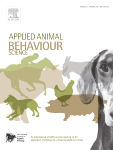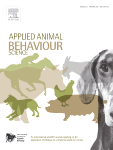Document type : Scientific article published in Applied Animal Behaviour Science
Authors: Manod Williams, Chelsea N. Davis, Dewi Llyr Jones, Emma S. Davies, Penelope Vasina, David Cutress, Michael T. Rose, Rhys Aled Jones, Hefin Wyn Williams
Preview: Lying behaviour has been shown to be highly valuable in supporting the productivity and welfare of cattle. The aim of this experiment was to investigate the effect of biological and physical factors on the lying behaviour of sheep. Ninety-six Bluefaced Leicester x Welsh Mountain crossbred (Mule) ewes managed to lamb indoors, and 80 Welsh Mountain (WM) ewes managed to lamb at grass were used for the study. Acceleration values were collected for the two flocks from accelerometers fitted vertically to the outside of the rear right leg and set to record at 1-min intervals for at least 14 d prior to parturition. Ewes were simultaneously recorded using video equipment to identify lambing and to verify predictions of lying (total lying time, mean lying bout duration and total number of lying bouts) using data collected from 10 randomly selected ewes from the indoor flock on day -10 prior to lambing. Linear regression was used to evaluate predicted behaviours with video footage. Predictions of total lying time (R2 ≥ 0.99; P > 0.05 for slope = 1, intercept = 0), mean lying bout duration (R2 ≥ 0.99; P > 0.05 for slope = 1, intercept = 0) and total number of lying bouts (R2 ≥ 0.98; P > 0.05 for slope = 1, intercept = 0) were strongly associated with video footage (P < 0.001) demonstrating that a 1-min sampling interval provides reliable estimates of ewe sleeping behaviours. Measures of lying (mean daily lying time, mean lying bout duration and mean daily lying bouts) were calculated for all ewes using averages taken across days -10, -9 and -8 prior to lambing. Linear regression was used to test for effects of independent variables (pregnancy scan result (single- or twin-bearing), ewe age, ewe BCS, lambing ease, lamb sex and lamb birth weight) on each measure of lying. Significant associations (P < 0.05) were found between measures of lying and pregnancy scan result, ewe age, sex of singleton lambs and twin birth weight for housed, Mule ewes. Only ewe age and twin birth weight were significantly associated (P < 0.05) with measures of lying for WM ewes managed at grass. This information could help guide further research on sheep behaviour for management purposes (e.g., to optimise stocking densities and welfare for pregnant ewes). Further work should also consider evaluating measures of lying as proxies for imminent parturition.






